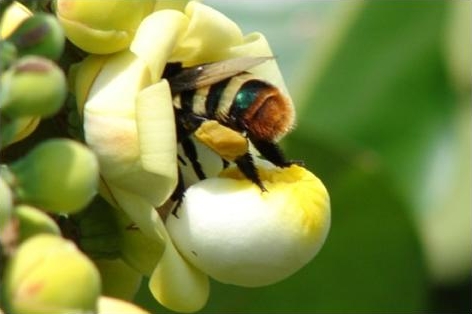Eulaema on:
[Wikipedia]
[Google]
[Amazon]
 ''Eulaema'' is a
''Eulaema'' is a

 ''Eulaema'' is a
''Eulaema'' is a genus
Genus (; : genera ) is a taxonomic rank above species and below family (taxonomy), family as used in the biological classification of extant taxon, living and fossil organisms as well as Virus classification#ICTV classification, viruses. In bino ...
of large-bodied euglossine bees that occur primarily in the Neotropics
The Neotropical realm is one of the eight biogeographic realms constituting Earth's land surface. Physically, it includes the tropical terrestrial ecoregions of the Americas and the entire South American temperate zone.
Definition
In biogeog ...
. They are robust brown or black bees, hairy or velvety, and often striped with yellow or orange, typically resembling bumblebee
A bumblebee (or bumble bee, bumble-bee, or humble-bee) is any of over 250 species in the genus ''Bombus'', part of Apidae, one of the bee families. This genus is the only Extant taxon, extant group in the tribe Bombini, though a few extinct r ...
s. They lack metallic coloration as occurs in the related genus '' Eufriesea''.
Distribution
''Eulaema'' is found fromRio Grande do Sul
Rio Grande do Sul (, ; ; "Great River of the South") is a Federative units of Brazil, state in the South Region, Brazil, southern region of Brazil. It is the Federative units of Brazil#List, fifth-most populous state and the List of Brazilian s ...
(Brazil
Brazil, officially the Federative Republic of Brazil, is the largest country in South America. It is the world's List of countries and dependencies by area, fifth-largest country by area and the List of countries and dependencies by population ...
), Misiones (Argentina
Argentina, officially the Argentine Republic, is a country in the southern half of South America. It covers an area of , making it the List of South American countries by area, second-largest country in South America after Brazil, the fourt ...
) and Paraguay
Paraguay, officially the Republic of Paraguay, is a landlocked country in South America. It is bordered by Argentina to the Argentina–Paraguay border, south and southwest, Brazil to the Brazil–Paraguay border, east and northeast, and Boli ...
to northern Mexico
Mexico, officially the United Mexican States, is a country in North America. It is the northernmost country in Latin America, and borders the United States to the north, and Guatemala and Belize to the southeast; while having maritime boundar ...
with occasional strays into the United States
The United States of America (USA), also known as the United States (U.S.) or America, is a country primarily located in North America. It is a federal republic of 50 U.S. state, states and a federal capital district, Washington, D.C. The 48 ...
.
Behavior
Like other euglossine bees, male ''Eulaema'' gather and store scents to attract females. Scientists use different mixes of scents to study these bees, includingeugenol
Eugenol is an allyl chain-substituted guaiacol, a member of the allylbenzene class of chemical compounds. It is a colorless to pale yellow, aromatic oily liquid extracted from certain essential oils especially from clove, nutmeg, cinnamon, ...
, cineole, vanillin, skatole
Skatole or 3-methylindole is an organic compound belonging to the indole family. It occurs naturally in the feces of mammals and birds and is the primary contributor to fecal odor. In low concentrations, it has a flowery smell and is found in sever ...
and methyl salicylate
Methyl salicylate (oil of wintergreen or wintergreen oil) is an organic compound with the formula C8H8O3. It is the methyl ester of salicylic acid. It is a colorless, viscous liquid with a sweet, fruity odor reminiscent of root beer (in which it ...
. However, this list is not exhaustive. After collecting scents, males choose a branch or tree trunk in an area with more open canopy to make their displays. These displays consist of bouts of movement and buzzing before returning to their perch or mating. When they are not foraging and collecting scents, males may reuse refugia, like flowers, for sleeping. Females nest in tree hollows, buildings, or soil banks, with some reports of cooperative nesting. They collect nectar, pollen, and nest building materials such as mud, resin, and fecal matter to provision their young and build nests. Interestingly, scientists report a wide range of social habits in reproductive females. Some live in solitary nests while others live in large groups. One study reported a nest including two different species. There is not current evidence that generations overlap. So, it is unlikely that daughters stay in the nest to help rear more sisters or their own daughters. Despite their behavioral plasticity, ''Eulaema'' females are not eusocial. Daughters and sons leave the nest and reproduce separately, starting the cycle anew. While ''Eulaema'' generally reproduce year-round, local fluctuations in climate affect abundance and activity. For those interested in learning more, '' Eulaema meriana'' is a good species to start with.
Species

References
{{Taxonbar, from=Q4038261 Bee genera Hymenoptera of North America Hymenoptera of South America Orchid pollinators